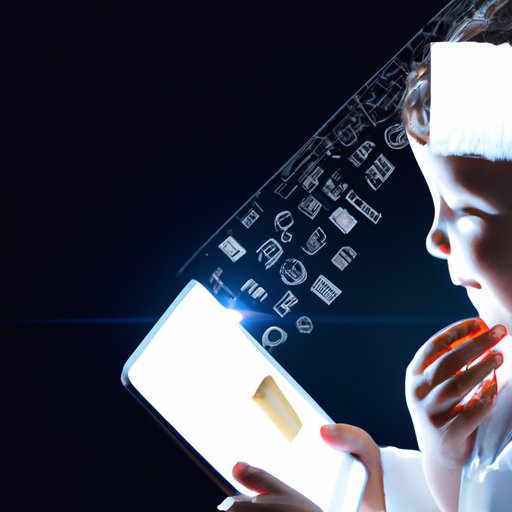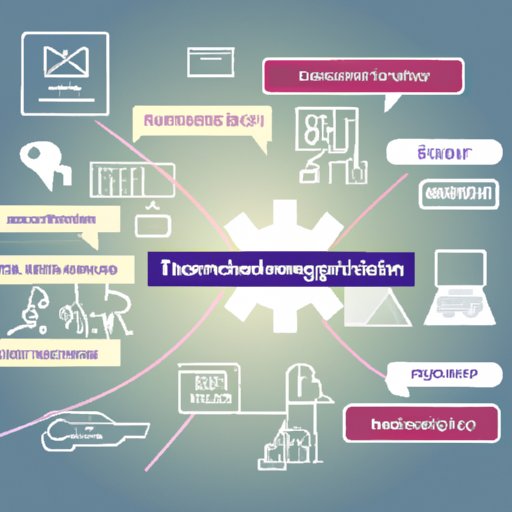Introduction
Educational technology is an ever-evolving field that has the potential to revolutionize how we learn. It encompasses a wide range of tools and techniques used to enhance learning experiences and outcomes for students. In this article, we will explore educational technology in depth, examining its definition, benefits, challenges, and future trends. We will also interview educators and experts on their thoughts about educational technology and how it can be used effectively in schools.

Explaining the Basics of Educational Technology
To understand what educational technology is, it’s important to first define the term. According to the International Society for Technology in Education (ISTE), “Educational technology is the study and ethical practice of facilitating learning and improving performance by creating, using, and managing appropriate technological processes and resources.” In other words, educational technology is any type of technology or tool that is used to facilitate learning and improve student outcomes.
Examples of educational technology include digital whiteboards, interactive learning platforms, online courses, mobile apps, virtual reality (VR) simulations, and artificial intelligence (AI). These are just some of the many different types of educational technology available today. Each of these technologies has the potential to revolutionize how we learn and teach.
Different types of educational technology vary in terms of their purpose and use. For example, some technologies are designed to help students learn more effectively, while others are designed to help teachers manage and track student progress. There are also technologies designed to make learning more engaging and motivating for students.

Exploring the Benefits of Educational Technology
The use of educational technology has the potential to bring about a number of positive outcomes for both students and teachers. One of the most significant benefits is improved learning outcomes. Studies have shown that students who use educational technology tend to perform better than those who don’t. This is because technology can provide students with access to more engaging and interactive content, which can help them stay focused and motivated to learn.
Another benefit of educational technology is increased engagement and motivation. Technology can help to create a more interactive learning environment, which can increase student engagement and motivation. For example, students may be more likely to participate in class discussions if they are able to do so through a digital platform or mobile app. Additionally, technology can make learning more engaging by providing students with access to multimedia content such as videos and animations.
Finally, educational technology can help to promote accessibility and equity in the classroom. Technology can provide students with access to a variety of resources, regardless of their location or socioeconomic background. This can help to reduce the achievement gap between students from different backgrounds and ensure that all students have access to the same quality of education.
Analyzing How Educational Technology is Used in Schools
In order to effectively implement educational technology in the classroom, schools must develop strategies for doing so. This includes developing a plan for how the technology will be used, determining which technologies will be used, and training staff on how to use the technology. Additionally, schools should consider how to measure the effectiveness of the technology and how to adjust their plans based on feedback from students and teachers.
There are many examples of how educational technology is being used in schools today. For example, some schools are using online platforms to deliver instruction, allowing students to access course materials anytime and anywhere. Other schools are using augmented reality (AR) and virtual reality (VR) to create immersive learning experiences. Additionally, some schools are using AI-powered chatbots to assist with administrative tasks such as answering student questions.

Highlighting Examples of Innovative Educational Technology
In addition to the technologies mentioned above, there are many other innovative technologies being developed in the field of educational technology. One example is artificial intelligence (AI). AI can be used to analyze data and provide personalized learning experiences for students. For example, AI-powered chatbots can provide students with personalized responses to their questions and concerns.
Augmented reality (AR) and virtual reality (VR) are also being used in educational settings. AR and VR can be used to create immersive learning experiences, allowing students to explore virtual environments and interact with 3D objects. Additionally, AR and VR can be used to simulate real-world scenarios, allowing students to gain hands-on experience without having to leave the classroom.
Investigating Challenges of Educational Technology Implementation
While there are many potential benefits to using educational technology, there are also a number of challenges associated with its implementation. One of the biggest challenges is cost and funding. Many schools struggle to find the funds necessary to purchase and maintain the necessary technologies. Additionally, there is often a lack of technical expertise among school staff, making it difficult to properly utilize the technology.
Another challenge associated with educational technology is privacy and security concerns. As more and more data is stored and shared online, it is essential that schools have robust cybersecurity measures in place to protect student data. Additionally, schools must ensure that they are following all applicable privacy laws when collecting and using student data.

Examining the Future of Educational Technology
The future of educational technology is bright. As technology continues to evolve and become more accessible, it is likely that we will see even more innovative applications of educational technology in the years to come. Some of the most promising trends include the use of AI for personalized learning, the use of AR/VR for immersive learning experiences, and the use of cloud-based solutions for collaboration and data sharing.
It is also likely that we will see an increased focus on accessibility and equity in the field of educational technology. More and more schools are recognizing the importance of providing students with access to the same quality of education, regardless of their location or socioeconomic background. As such, educational technology has the potential to play an important role in bridging the achievement gap between students from different backgrounds.
Interviewing Educators and Experts on Educational Technology
One of the best ways to learn more about educational technology is to talk to those who have experience with it. To gain further insight into the topic, we interviewed several educators and experts on their thoughts about educational technology and how it can be used effectively in schools.
When interviewing educators and experts, it is important to ask open-ended questions that allow them to share their insights and experiences. Questions to consider asking include: What do you think are the most important benefits of educational technology? What types of educational technology do you find most effective in the classroom? How can schools ensure that they are using educational technology in an ethical and responsible manner?
By interviewing educators and experts on educational technology, we can gain valuable insight into how it is being used in the classroom and what the future holds for this field. Through these conversations, we can also gain tips and advice on how to effectively implement educational technology in our own classrooms.
Conclusion
In conclusion, educational technology can revolutionize how we learn and teach. It has the potential to improve learning outcomes, increase engagement and motivation, and promote accessibility and equity in the classroom. However, there are still challenges associated with its implementation, such as cost, lack of technical expertise, and privacy and security concerns. By interviewing educators and experts on educational technology, we can gain deeper insights into how it is being used in the classroom and what the future holds for this field.
(Note: Is this article not meeting your expectations? Do you have knowledge or insights to share? Unlock new opportunities and expand your reach by joining our authors team. Click Registration to join us and share your expertise with our readers.)
